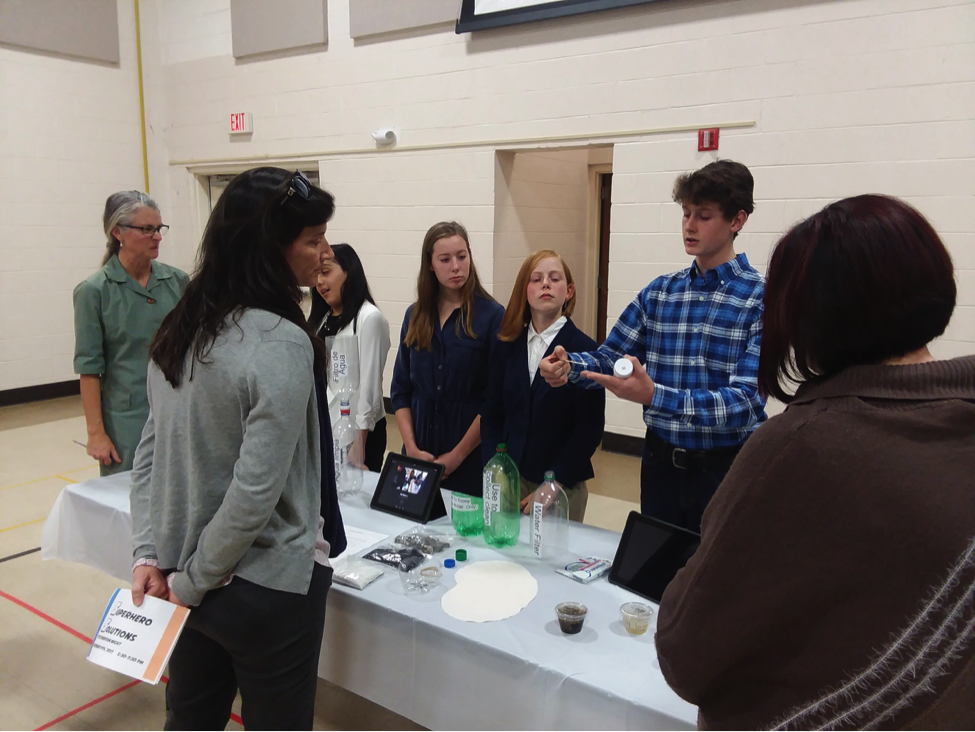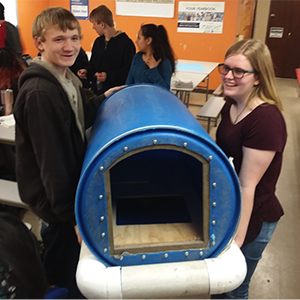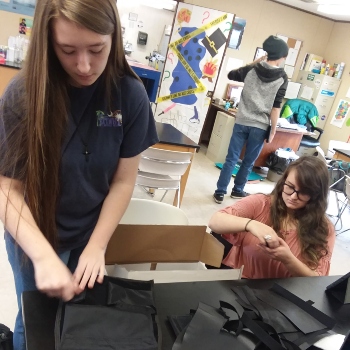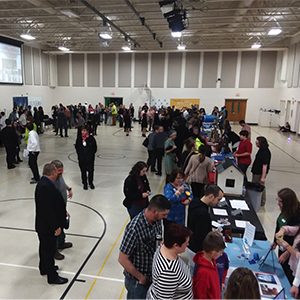 It was already 4:30, two hours after school was out, and students were still there. One of their fathers, a contractor, was assisting them with their project – a floating pet kennel and waterproof document holder designed for floods. I asked them to shut the lights off in my room when they were done. It was another one of those projects at Tri-County Early College (TCEC) that had students so engaged that they stayed for hours after school just to work with their groups.
It was already 4:30, two hours after school was out, and students were still there. One of their fathers, a contractor, was assisting them with their project – a floating pet kennel and waterproof document holder designed for floods. I asked them to shut the lights off in my room when they were done. It was another one of those projects at Tri-County Early College (TCEC) that had students so engaged that they stayed for hours after school just to work with their groups.
Last year, as the fall progressed and one hurricane after another pummeled the southeastern U.S. and Virgin Islands, while the western U.S. struggled to extinguish raging wildfires, we decided to direct our students’ attention towards a service learning project. To bolster their awareness of these issues, we created a Hyperdoc to inform them.
Real-World Problem-Solving
T ime and again, we have found that authentic problem-solving lights our students up. If we can tell them about a true issue impacting people or the environment, their passions ignite and lead to the most engaging Project Based Learning experiences. So, we designed a project with the driving question: How can we identify problems and create practical solutions to support communities impacted by natural disasters?
ime and again, we have found that authentic problem-solving lights our students up. If we can tell them about a true issue impacting people or the environment, their passions ignite and lead to the most engaging Project Based Learning experiences. So, we designed a project with the driving question: How can we identify problems and create practical solutions to support communities impacted by natural disasters?
All projects at TCEC are designed by the entire teaching staff and implemented schoolwide. This ensures that each project can connect well with our class content and provides an ideal way to ensure students receive a consistent high quality PBL model in every class. For newer staff members, this has also enabled them to learn the ropes of PBL surrounded by experienced colleagues.
This natural-disaster-focused project (called “Superhero Solutions”) kicked off with an Entry Event where students met community members who had been involved with disaster relief efforts. The purpose of the fair-like assembly was to highlight the various problems that hinder emergency management and relief efforts. Community leaders in the Forest Service, Emergency Management Services, and various relief organizations discussed these problems as they related to the phases of emergency management: preparation, prevention, response, and recovery.
Afterwards, we focused the students on problem identification before jumping to the solutions. Oftentimes, we have witnessed students creating solutions for problems that don’t exist, so we wanted to counteract that tendency. Once they had focused on one problem area, we identified group leaders based on past PBL performance. The leaders then recruited and chose teams based on common interests using a “Speed Dating” group selection protocol we created.
Phase 1: Project Proposal
 After they had created their group contracts, they got to work. In Phase 1 of the project, we had them further dissect the problem using a Problem Identification, then a Solutions Brainstorm Graphic Organizer. The phase culminated with students creating a Project Proposal, which they presented to the group, then received peer feedback. We could tell it was going to be a great project by the exciting ideas – things like recycled $5 DIY water filters, floating tent platforms, fireproof houses, and animal welfare awareness campaigns.
After they had created their group contracts, they got to work. In Phase 1 of the project, we had them further dissect the problem using a Problem Identification, then a Solutions Brainstorm Graphic Organizer. The phase culminated with students creating a Project Proposal, which they presented to the group, then received peer feedback. We could tell it was going to be a great project by the exciting ideas – things like recycled $5 DIY water filters, floating tent platforms, fireproof houses, and animal welfare awareness campaigns.
One of the other unique parts of this project design was the prototyping emphasis. Like many PBL teachers, we had seen procrastination countless times that resulted in a group’s initial prototype becoming their final product. With this project, we decided to create milestones that emphasized iterating prototypes with feedback sessions on every due date. This was a nod to the engineering design process, which encourages rapid prototyping and a “fail forward” mindset.
We found this approach to be very effective for helping students move quickly and increasingly refine their products at each stage. Moreover, the presentations at the end of each phase amplified student accountability. If students only check in with a teacher about a milestone, they will sometimes blow it off, but if a public audience is used at each milestone, it changes the game.
To further enhance the product designs, we required every group to recruit a mentor relevant to their project ideas. This practice, which is part of an Open Source Learning framework, helps students assess the feasibility of their ideas, create a network of support in the community, and enhance their final products. Students partnered with local non-profits, leveraged the contacts we introduced them to at the entry event, and reached out to organizations around the nation doing disaster relief work. One group even got a Division of Air Quality Specialist to travel two hours for a face-to-face meeting with them while another collaborated with a local factory to create a survival backpack!
Phase 2: Mentor Feedback & Exhibition
 Phase 2 required students to solicit and integrate feedback from their mentors. Between phases we would frequently check in with groups to see how they were using the feedback to improve their products. By having public presentations for milestones and focusing on iteration, we were acutely aware of each group’s progress by the time Exhibition Night came along, so we were confident to make it the biggest event our school had ever hosted.
Phase 2 required students to solicit and integrate feedback from their mentors. Between phases we would frequently check in with groups to see how they were using the feedback to improve their products. By having public presentations for milestones and focusing on iteration, we were acutely aware of each group’s progress by the time Exhibition Night came along, so we were confident to make it the biggest event our school had ever hosted.
When Exhibition Night finally arrived, students meticulously arranged their tables at the “Trade Fair” style event. Groups had materials to distribute, beautiful prototypes, and some even printed business cards promoting their “brand.” Because they had already pitched their ideas multiple times at the milestones, the hundreds of parents, mentors, and community members who attended were treated to polished presentations.
We were very excited to see our students become so enthusiastic about helping natural disaster victims by doing some of their highest quality work. We encourage other teachers to integrate some of the most successful elements of this project: team teaching, Open Source Learning, authentic problem solving, public audiences at milestones, giving and receiving feedback, and iterating prototypes. Feel free to borrow the project design by visiting the project website and follow me @adamhaigler to find out more about TCEC’s projects.
Adam Haigler (@adamhaigler) has spent more than ten years working in educational settings as an outdoor educator, international educator, energy conservation educator, and classroom teacher. He is currently co-authoring a book on Open Source Learning to be released this year.

